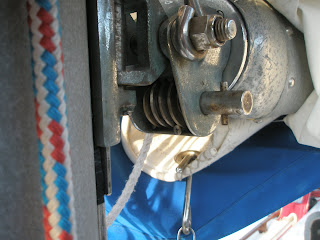The 2-year ongoing cooler project continues! Having ripped out the silly, poorly insulated, and inefficient old cooler (for reference, see
http://calliopelog.blogspot.com/2008/05/cooler-framing-rough-in.html), I finally managed to get new cooler construction to the top of the list and focused this past weekend on completing this project.
My friend Pam came out yesterday (Sunday) and helped me with cutting and installing the cooler insulation. The plan for this project calls for 3" of insulation on all cooler sides except the ER bulkhead which will have 4" of insulation. The innermost layer of insulation gets treated with fiberglass. The bottom layers get woven roving followed by 2 laminations of 1708 biaxial, followed by 2 laminations of 10 oz cloth. Then when the fiberglass is kicked these panels will get inserted into the cooler and the seams will be taped over thickened resin in the joints to bond them all together. The top of the cooler will be a separate and fully removable piece so that it can be removed for servicing. The cooler top will be separately insulated with 2" thick foam.
The foam that I used is Polyisocyanurate foam available at Home Depot in 4x8' sheets. They are about $30 each. I used almost a gallon of polyester resin doing the fiberglass work. I attached the foam to the bulkheads with silicone sealant and filled in the cracks between foam blocks with 'great stuff' sprayable foam also available at Home Depot for about $6 per can.
One feature which is very important to me is that the cooler have a very good drain. My previous cooler had a terrible, small drain that was useless because it clogged ALL THE TIME and it did not drain properly. Also it was not possible to close the drain so there was no ability to keep cold water in the cooler. Furthermore it did not have a trap so cold air simply leaked right out of it into the engine room. It was made of copper therefore that also conducted heat straight out of the engine room and into the cooler. Finally, the drain hose always sent water down the side of the engine beds, not direct into the bilge. In short, the old drain sucked, and I am intent on having a very good drain in the new cooler. Therefore, I bought at Home Depot a 1.5" bathroom sink drain with a closing fixture and PVC trap and tailpipe which will go straight down into the bilge. This should make the cooler easy to clean and easy to keep cold. So it's an important feature and I'm sure there will be a full post just on the drain at some point in the future...
The cooler will have one level of shelves which will serve to subdivide it vertically. I will also install one longitudinal bulkhead member to divide it in half transversely. The subdivisions increase usable space in the cooler. If I get fancy enough, I may decide to install a condiment rack...
Without further ado and before I get carried away, on to the pix:

This is the aft bulkhead with the first piece of foam installed.

This is looking outboard you can see the first pieces of 1" thick foam installed on the forward and aft transverse bulkheads.

This is looking inboard at the engine room bulkhead (inboard, longitudinal bhd) and the 2 transverse bulkheads (forward is on the left).

The forward, inboard joint.

Pam 'The Cut Woman' Jacobson looks up from the layout table.

This is after installation of the cut and tapered pieces along the hull surface. These were made from 2" foam and cut/tapered (by Pam) to fit the contour of the hull.

This is looking down at the bottom. Inboard long'l bhd (ER bhd) is on the bottom of this picture. Forward transverse bhd is on the right. The bottom is made to slope inboard and forward. There will be a 1.5" drain in the inboard, forward corner of the cooler.

Looking inboard and down. This is the bottom of the cooler. Forward is toward the bottom of this picture.

Another shot looking down. This picture includes the full 4" insulation (1", 2", 1" layers) on the ER bulkhead (bottom of picture). The forward transverse bhd is on the right and you can see the full 3" of insulation on that bhd.

Another shot of the completed insulation. Note the small wedges that we use to get an exact fit where our measuring has been less than flawless.

Looking inboard and forward, this is the seam between the ER bhd and the forward, transverse bhd with the cutout for the drain at the bottom.

Inner panels, having been laminated, left in the sun to cure.

Closer shot of the inner panels with fiberglass on them. The fiberglass doesn't go all the way to the edges because the seams will be taped anyway and it's easier to avoid having to trim the glass.

Very close up shot of one of the panels with fiberglass lamination on it. You can see how I made sure we would laminate the right side of the panel!

















































